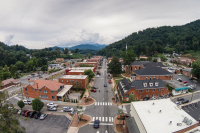Balancing grades, world-class training no problem for SCC Early College student
 By Tyler Norris Goode • Contributor
By Tyler Norris Goode • Contributor
Rowan Stuart’s favorite kayak maneuver is called the “Phonics Monkey” and involves spinning the vessel on its bow like a pirouette for a full 360 degrees then flipping the boat end over end.
There’s nothing easy about the trick, but Stuart’s ability to cleanly achieve it at high-level competitions is a big reason she’ll be competing in the Freestyle World Championships, the premier competition for freestyle paddling athletes, that start Sept. 2 in the Nantahala Gorge.
What is freestyle kayaking?
 Combining an array of difficult tricks, precision paddling and finely tuned choreography, freestyle kayaking can be described as aquatic gymnastics.
Combining an array of difficult tricks, precision paddling and finely tuned choreography, freestyle kayaking can be described as aquatic gymnastics.
Meet the athletes
 Peter Csonka
Peter Csonka
Age: 28
Country: Slovakia
Awards: 2012 World Cup Champion
Day job: Kayak retailer
I was 12 when I started paddling. We had a group of kids doing canoe sports, traveling around and doing competitions. It was really nice to have those trips together. At that time, we all were just starting to race and do rafting, doing small competitions, sometimes winning, sometimes losing.
NOC nears finish line in preparing for kayaking worlds
 Sitting at a picnic table alongside the Nantahala River, Charles Conner watches the fast moving water. It’s may be a peaceful sunny morning at the Nantahala Outdoor Center, but it’s the calm before the storm.
Sitting at a picnic table alongside the Nantahala River, Charles Conner watches the fast moving water. It’s may be a peaceful sunny morning at the Nantahala Outdoor Center, but it’s the calm before the storm.
“Right now, we’re really excited but anxious because there’s so much left to do,” he said.
River-lust spurs building rebound on Nantahala: Tiny riverside lots pose sewage conundrum
 Tom Anderson barely batted an eyelash when he plunked down $300,000 in cash for a tiny lot along the Nantahala eight years ago in the Mystic River development.
Tom Anderson barely batted an eyelash when he plunked down $300,000 in cash for a tiny lot along the Nantahala eight years ago in the Mystic River development.
Paddlers hit the river in wake of torrential downpours
 The recurring deluge of heavy rains has brought paddlers out of hibernation and onto Western North Carolina rivers over the past few weeks.
The recurring deluge of heavy rains has brought paddlers out of hibernation and onto Western North Carolina rivers over the past few weeks.
Changing course while keeping afloat: NOC’s new owners try to improve bottom line while keeping core values
The Nantahala Outdoor Center rose rapidly from a scrappy operation spawned by idealistic river rats in the 1970s to one of the largest and most renowned outfitters in the country. Now in its 40th year, NOC has struggled during the past decade to reconcile its founding philosophy — that of like-minded outdoors lovers carving out a living doing what they loved — with changing economic realities.
Corridor K debate going nowhere
Will it decimate mountain beauty or open the economic flood gates?
Either way, the costly missing link of a four-lane highway through the remote southern mountains has hit a startling and potentially insurmountable roadblock. State and federal agencies are reluctant by some accounts — downright unwilling by other accounts — to issue essential environmental permits. Without them, the missing link can't go forward.
So for now, an 18-mile, $800 million highway through Graham County known as Corridor K is at an impasse.
Graham County is the final piece of a four-lane highway stitching together the seven, peak-pocked western counties before surging onward to Tennessee, blazing a pseudo-interstate from Asheville to Chattanooga.
The highway was envisioned nearly 50 years ago. Its purpose: to transform the far corner of Western North Carolina from an Appalachian backwater to economic prosperity.
"It was the same everywhere in Appalachia. It was just twisty two-laners, and it was a long trip to get anywhere," said Bill Gibson, the director of the Southwestern Commission, a governmental planning unit located in Bryson City for the seven western counties.
A lot has changed in the intervening decades, however. For starters, the region isn't exactly a backwater anymore. Also, environmental laws are much stronger, and road building is a lot more expensive.
But, Graham County is still clamoring for its promised piece of four-lane. Indeed, four-lane highways have been delivered to all the western counties except for Graham thanks to a special pot of federal road building money funneled to the region through the Appalachian Regional Commission since it was set up in the 1960s.
"I think to shortchange a small part of Western North Carolina of their opportunities is wrong," said Joel Setzer, head of the N.C. Department of Transportation for the western counties. "We got ours. We should care whether they get theirs."
Graham County's 18-mile missing link of the highway, pegged to cost from $700 to $900 million, is the most rugged, remote and environmentally challenging. The highway would bury streams and wetlands, cut into mountains and require a half-mile long tunnel.
Meanwhile, Graham County leaders blame their 18 percent unemployment rate and high poverty on the lack of a four-lane highway.
Graham County has come to view Corridor K as a silver bullet, the one thing separating it from the advances realized elsewhere in the mountains. If built, the county's unemployment and poverty would darn near solve themselves, leaders claim.
This easy fix to Graham's economic woes has proved anything but however.
"It has been studied to death," said Mike Edwards, the chairman of the Graham County commissioners. "It has been going on for four decades, and it has reached a point now where it is getting more and more difficult to justify building 18 miles of road."
So hard to justify, in fact, that the project has reached a stalemate. There's 10 different agencies, from the Environmental Protection Agency to the N.C. Wildlife Resources Commission, that can make or break the project by refusing to issue essential permits.
A few of these agencies are questioning whether the road is worth it. Given the price tag and environmental damage, will it truly bring the hoped for economic benefits?
"The regulatory agencies seem to be stuck," Gibson said. "They are saying why should we go through all this permitting if we aren't sure that the purpose and need really exists as was forecast? Will this realize economic development and improve lives? Is it true that this road is needed in the way that DOT now has it laid out?"
Misguided goal?
Economic development was once a driving force behind new highways. But, it is mostly touted as a side benefit these days rather than heralded as the sole purpose.
D.J. Gerken with the Southern Environmental Law Center in Asheville said it is rare to see road construction justified with economic development.
But, Setzer pointed out that was the rationale behind the four-lane highways in the seven western counties. From the bypass in Waynesville to the four-lane in Franklin, all were pursued for economic development under the banner of the Appalachian Regional Commission highway program.
"The purpose of the program was to end isolationism in the Appalachian region," Setzer said.
The question now, however, is whether that rationale is still relevant and will it work for Graham.
"It is not going to be the silver bullet they think it is," said Brent Martin, the Sylva-based Southern Appalachian director for The Wilderness Society.
State and federal agencies holding up the new highway have questioned whether there are other solutions to economic challenges in Graham County. They have also questioned whether the goal of ending Appalachian isolation when the highway was envisioned is still relevant today.
"It is doubling down with a half billion investment on an economic development plan from the 1960s rather than asking the question," Gerken said. "If Congressman Heath Shuler said 'I have half a billion to invest in Graham County economic development and just started taking ideas, I suspect you would get a lot better suggestions."
Building an $800 million highway for a county of 9,000 people is particularly problematic when there's no evidence to show it will accomplish economic development.
In a way, the state and federal agencies holding up the permits didn't have a choice, Gerken said.
"It is rare for a project to be so lacking in a clear purpose that the agencies are forced into this position," Gerken said. "The law states clearly that projects like this one cannot be given the required permits if there are practical alternatives that will cause less damage."
Nonetheless, the resistance by agencies to sign off on permits for the highway is unprecedented.
"I was a little surprised, but given the environmental impacts, these agencies are doing their job," Martin said.
Along with the run-of-the-mill road-building complaints that are par for the course in Appalachia — from despoiling historic farmsteads to fragmenting wildlife habitat — Corridor K in Graham County has some particularly sticky environmental challenges. It would mar views from the Appalachian Trail. It would cut through acidic rock with the potential to pollute streams. It would go through terrain that's steep even by mountain standards. And, it would require a half-mile tunnel.
Critics claim these would detract from the natural beauty Graham has to offer.
"I disagree with that, but I certainly understand the point of 'don't destroy what it is you are trying to enhance,'" Setzer said.
As for the tunnel, Setzer sees it as an environmentally sensitive solution. It goes under the Appalachian Trail, avoiding a major highway crossing for hikers. It could also be a possible tourism boon.
"There might be people who come to drive the road just to go through the tunnels," Setzer said.
Tired of waiting
Graham County leaders believe a four-lane highway is what separates them from their more prosperous neighbors — both literally and figuratively.
The county's unemployment rate of 18 percent is the highest in the state. It also has the highest rate of child hunger.
"That is my reasoning for trying to advance corridor K as soon as possible because of how destitute the area is," said Roger Shuler, a retired contractor in Robbinsville.
Graham is not only poor but small, with young people leaving to find work.
"The thing you always gave kids for a graduation gift was a suitcase," said Edwards, the chairman of the county board.
A four-lane highway could change that. It would not only bring business but quicker commutes to everything from shopping to jobs to Western Carolina University.
"When people think economic development, they think factories and four-lanes and tractor trailers. That is very narrow. It is also access to health care and access to education and access to tourism assets," said Ryan Sherby, planning liaison with the Southwestern Commission.
The biggie for many is access to medical care since Graham lacks a hospital.
"We have too many people being flown out of the community on an emergency helicopter at $15,000 a ride," said Edwards, a retired teacher and school administrator.
But with $800 million on the table, Graham County could build a hospital instead of a road. It could solve education woes by building a satellite university campus, Martin said.
"You could bring in an entire team of economists to come up with an economic development plan in Graham County for that much money," Martin said.
Some question whether the county has embraced the economic options at its fingertips now.
"What I would say to Graham County leaders is focus on what you have," said Julie Mayfield, director of WNC Alliance, a regional environmental group. She rattled off the diverse and unique outdoor tourism appeal of Graham County: the scenic Cherohala Skyway, Joyce Kilmer's giant trees, Lake Santeetlah, class V paddling on the Cheoah, Tsali mountain biking and the world-class motorcycle ride known as the Tail of the Dragon.
"We go to vacation in Graham County," said Mayfield, who lives in Asheville. "I am no PR expert, but I am confident I could design a tourism brochure for Graham County that would draw more outdoor recreation tourism."
While Graham County laments its plight as the only county in the state without a four-lane road, it's actually an asset, Mayfield said.
"I would celebrate that. I think there are a lot of people who would go to Graham County because it is a hidden gem," Mayfield said. "There is an audience there to be appealed to."
But, Edwards said the four-lane highway would actually help tourism if Graham County wasn't so hard to get to.
"The easier it is to get here the more likely they will come," Edwards said.
Graham County may be the last county without a four-lane — but it is also the last county that is completely dry. Even the grocery stores in Robbinsville don't sell beer or wine.
When asked whether the lack of alcohol could be a deterrent to young people staying in Graham County or hurting tourism, Edwards didn't deny it.
"It has been said by some, but that is a very volatile issue," Edwards said, adding there are no plans to change it.
Age-old debate
Highway supporters in Graham blame outside environmentalists for holding up progress.
"They want to come and tell us, 'No you cannot build a road because it devastates our landscape,'" said Roger Shuler a Graham County resident.
These outsiders have packed the numerous public hearings on Corridor K over the years, painting a tainted picture of public opinion, said Edwards, chairman of the Graham County commissioners.
"The thing that gets me is there is always an outside influence that wants a say-so on what is going to impact us here locally," said Edwards. "We've been impacted from attorneys of every flavor of organization over the years.
I respect that, but the 9,000 people in my county have to be accounted for in the environmental argument. The people here have a right to life, liberty and the pursuit of happiness."
That doesn't change the reality of environmental court challenges should the road proceed. In fact, the threat of lawsuits was among the concerns cited by resource agencies that are holding up the project as currently designed.
The road known as Corridor K has long been mired in a philosophical debate that on the surface pits outside environmentalists against more conservative locals.
But that would be over-simplifying things. Retirees lean both ways — some eager for quicker access to a hospital and others relishing the rural lifestyle.
Some multi-generation families in Graham are eager for progress the highway will surely bring, but others fear an erosion of their heritage and way of life.
Even the outdoor industry is torn. Getting tractor-trailers out of the paddling-crazed Nantahala Gorge would no doubt please some rafting companies and kayakers, who would no longer have to worry about the barreling freight traffic. But outdoor enthusiasts like the rugged nature of Graham County's prized recreation areas.
These debates are merely academic, however, as long as the state and federal agencies continue to dig in. Many local advocates for the project don't even realize it's in jeopardy, however.
"We think our chances are very good," said Antoinette Burchfield, with the local Corridor K Coalition. "We think it is going to be sooner than everybody realizes."
Birchfield knew nothing of the impasse with federal agencies about permits, asking whether that was the same as the lawsuits being threatened by outside environmental groups.
Birchfield has been going door-to-door to county commissioner and town board meetings in the seven western counties seeking an official endorsement for Corridor K. She has racked up an impressive number of formal resolutions from local government bodies, suggesting a majority of leaders in the region support their brethren in Graham County in its quest for a highway.
Two roads better than one
Ironically, the DOT's strategy to advance the highway has backfired. Instead of building the entire 18-mile missing link at one time, the DOT broke it into two roughly equal segments — one from Stecoah to Robbinsville and one leading on toward Andrews.
Only the first half is up for debate now. The other half — from Robbinsville to Andrews — would be years away.
"We didn't have the finances to go in and build the whole thing at one time because it is an expensive project," Setzer said.
Tackling one segment at a time was also seen as an easier route to dealing with environmental concerns. The drawn-out timeframe for the project meant the DOT had to keep revisiting its environmental assessments — first in the 1980s, again in the 1990s, and again a decade later. Redoing the environmental studies each time was a massive undertaking.
"We decided let's not do a plan that is going to have to be refreshed again. Let's separate it and do it in manageable chunks," Setzer said.
Agencies questioning the highway argue that the costs and environmental impacts should be analyzed in their entirety, not piecemeal.
Regardless, the DOT is now hamstrung by its piecemeal approach. If the DOT wants environmental impacts to be considered in standalone segments, the benefits must also be justified in standalone segments.
But, justifying the economic benefits of half a highway — the single 9-mile segment leading in to Robbinsville — hasn't worked.
"I think it is gong to be very difficult to quantify the economic impacts of building a four-lane road that will dead end in Robbinsville," Martin said.
Setzer agreed on that point. The economic benefits of the highway won't be fully realized unless both segments are built.
And, that begs the question: does building the first segment make the second segment a foregone conclusion?
The second segment is predicted to be even more expensive and environmentally challenging, but state and federal agencies fear they will be pigeonholed into approving it once the first one is already built, preventing a true analysis.
Setzer said tackling the entire missing link as a single project as some of the agencies want to do would essentially mean starting over — and would likely derail the process.
"It builds in certain delays and the longer you delay it the more apt funding will be seized for what somebody else thinks is more important," Setzer said. "We should allow the fragmentation to eventually get to the ultimate goal."
Money on the table
While opponents point to the sizeable price tag, money is not a hang up. The DOT has almost enough to build the first nines miles sitting in the bank, waiting on the green light. It has been saved up thanks to a special pot of federal highway dollars earmarked for the Appalachian region.
The money is burning a hole in the DOT's pocket and driving the project, according to critics.
"They either spend or they don't," Gerken said. "So they are trying to come up with a legitimate purpose for building this road."
The view is shared by at least some of the state and federal agencies.
"There are disagreements among the agencies about whether the project is really needed or is driven by the availability of Appalachian highway funding," states a report last year summarizing concerns of the agencies.
One of the agencies interviewed for the report said the special pot of money "creates a want without a substantiated need."
Preconceived notions
The DOT hit a stumbling block two years ago that in hindsight was a harbinger of more serious roadblocks to come. The Army Corps of Engineers, one of the many agencies that can make or break the project by denying permits, called for a partial do-over of the DOT's environmental analysis.
Several agencies were questioning why the DOT couldn't upgrade the existing two-lane highway through Graham County instead of building an entirely new one. The Army Corp sent DOT back to the drawing board to determine whether upgrades to the existing road would suffice.
They wouldn't, DOT determined.
The DOT countered that simply dressing up the winding two-lane road through Graham County with an extra climbing lane here and there, wider shoulders and gentler curves isn't really fixing the problem.
Cars just won't take a route around the Gorge if it is only marginally better.
"They say it has to be big enough and fast enough to lure traffic away from the Gorge," Gerken said.
Not surprisingly, Gerken doesn't think the DOT did an "adequate analysis" of upgrading existing roads.
"I would characterize it as a half-hearted attempt," Gerken said. "Because this is a project in search of a defensible purpose, DOT shouldn't have eliminated a lighter footprint from consideration. Targeted improvements to the existing roads could be built now without controversy and at a fraction of the cost."
Agencies holding up highway permits have been frustrated that DOT is unwilling to consider anything but a new four-lane highway. Critics say DOT has blinders on to anything except a four-lane highway and are refusing to think creatively about an appropriate road through the mountains.
"There seems to be all kind of options other than building your 'anywhere-in-America' four-lane," Martin agreed.
The existing road could be upgraded not just with climbing lanes, but all sorts of bells and whistles aimed at luring eco-tourists. Picnic areas, overlooks, wildlife viewing pull-offs, hiking trails, fishing access, cultural heritage sign boards could all be built in.
The premise is hard to argue with, no matter how many lanes a new road would have.
"If we do need a new road, let's design it so we can capitalize on the assets we do have," said Ryan Sherby, regional planner for the Southwestern Commissioner. "It would go through some fabulous public lands. Let's provide access to them."
Setzer said the goal is to get traffic now using the Nantahala Gorge to use the new highway instead, and if it isn't any faster, they won't take it. That means the road through the Gorge itself would have to be upgraded.
Even the reluctant state and federal agencies agree that the Nantahala Gorge is congested and unsafe, clogged for six months of the year with rafting buses and an onslaught of cars sporting kayaks on roof racks.
Gibson, director of the Southwestern Commission regional planning agency, has had a front row seat to the Corridor K debate over the decades. Brand new on the job in 1975, he traveled to Raleigh to see design options being considered by the DOT for a four-lane highway through Graham County.
One option was a double-decker highway through the Nantahala Gorge, achieving four lanes by stacking them on top of each other. Another was to divide the highway, with two lanes in one direction on one side of the river and two lanes in the other direction on the other side.
Those obviously fell by the wayside in favor of a new highway through Robbinsville. Yet three decades later, it is still floundering.
"The folks in Graham County are still waiting," Gibson said. "A lot of the people who hoped to see it in their lifetimes are gone now. Others who hoped to see it in their lifetimes are afraid they will be gone."
Will dollars flow down new highway?
Will a four-lane highway bring economic development to Graham County?
While local leaders and the N.C. DOT have a hunch that it will, state and federal environmental agencies aren't convinced and so far have refused to sign off on permits for the environmental damage the highway would cause.
But, there may be a way out of the impasse. A regional economic development plan for the seven western counties will be launched in coming months. It may prove the highway is needed, but likewise, it may not.
"Everything is on the table," said Ryan Sherby, a regional planner with the Southwestern Commission agency based in Sylva. "People need to quit thinking about fighting for a four-lane road. People need to think about what is our economic development vision for our region."
The study may indeed quantify the economic benefits of a four-lane road, and if so, highway supporters will have the justification that state and federal agencies say is lacking.
But, it may also show that there are other economic ideas. The Southwestern Commission will act as project manager, but an outside consultant will be brought in to lead the study. It will take 12 to 24 months and involve dozens of players.
The study will be funded with a piece of Appalachian highway money, but that doesn't mean road-building interests will have an inside track to influence the study's outcome, according to Joel Setzer, head of the N.C. DOT for a 10-county mountain area.
"We aren't trying to stack the cards," Setzer said, pledging that his agency is willing to let the "chips fall where they may."
A way through the impasse
The impasse over a $800 million four-lane highway in Graham County is a rarity in road building.
It is not uncommon for state and federal agencies to express concerns about a project's environmental impacts but rarely do they rise to the level of refusing to sign off on permits.
In hopes of breaking the logjam, a firm that specializes as mediators in environmental disputes was brought in to assess the prospects of a resolution and recommend a course forward.
The U.S. Institute for Environmental Conflict Resolution interviewed 58 stakeholders in early 2011 in hopes of ferreting out the hot button issues that must be solved.
"There are disagreements among the agencies about whether the project is really needed," the mediators concluded in their assessment. "Several agencies expressed the view that the environmental impacts are severe and that the expectations of economic benefits are not sufficiently supported to justify the environmental impacts."
Those interviewed include the Environmental Protection Agency, Army Corps of Engineers, N.C. Division of Water Quality, U.S. Fish and Wildlife, N.C. Wildlife Resources Commission, Appalachian Trail Conservancy, Eastern Band of Cherokee Indians, as well as local leaders, DOT and federal highways.
Here's a sample of concerns expressed by some of the agencies as listed in the mediators' report. The firm points out that not all agencies share the same level of concerns.
• There are many questions about whether the expectations of economic benefits from the road are realistic.
• There are disagreements among the agencies about whether the project is really needed or is driven by the availability of Appalachian highway funding.
• There are different perspectives among the agencies as to whether the recognized environmental impacts are worth the environmental costs, especially given uncertainty about the expectations of economic benefit from the road.
• There is disagreement about the feasibility of and plans for mitigating the environmental impacts, especially related to acidic rock.
• The feasibility, cost and desirability of the tunnel is a concern.
• The project is driven by a 'Build it and they will come' approach.
• Many are not clear about why the option of improving existing routes is not a viable alternative.
• The fact that the "Purpose and Need" was developed in the 1980s raises questions for some about whether it is still applicable and relevant.
Gorge gets a boost with new wave feature
The Nantahala River will soon boast one of the preeminent freestyle paddling features in the country — a patented apparatus that will create waves and holes used by trick kayakers.
The Wave Shaper will arrive just in time for a major world freestyle championship being held on the river in 2013, bringing 500 paddlers from 45 different countries and thousands of spectators to the Gorge. A $195,000 grant from the Golden Leaf Foundation was awarded to the Swain County Tourism Development Authority to fund construction of the wave.
“It will make us one of the premium whitewater kayaking places in the world,” said Brad Walker, chairman of the Swain tourism agency.
The wave is designed for freestyle kayaking — a paddling sport filled with technical tricks and highly-stylized moves, including spins, turns, cartwheels and flips that often involve the boater going completely airborne. The paddler surfs in place while performing the maneuvers on top of the wave.
The Nantahala will be one of only three rivers in the country using the cutting edge technology of the Wave Shaper, the creation of McLaughlin Whitewater Design Group based in Denver.
The Nantahala isn’t without a wave now — it couldn’t have landed the ICF Freestyle World Championships in 2013 without one. It was built by zealous paddlers on the Nanty who manhandled rocks around the riverbed to craft a high-caliber feature. And that in itself is impressive.
“A wave is very finicky. It is really hard to produce a good wave,” said Rick McLaughlin, owner of the McLaughlin Whitewater Design Group.
But it is susceptible to shifting currents and wash outs —far too tenuous to hang a world championship of this caliber on.
“Whenever there is a big rain you lose the feature you have to start all over again,” said Karen Proctor Wilmot, the executive director of the Swain County Chamber of Commerce and Tourism Development Authority. “They knew we could have one big rain during the event and be out there moving rocks and looking a little foolish.”
Such a faux pas could also cause quite a stir.
“Having a feature change during the course of a competition wouldn’t be fair to all the other athletes,” said Lee Leibfarth, an NOC paddling instructor and a lead organizer of the event.
Organizers said success of the event hinged on a proper wave. Otherwise, it would be like playing Wimbledon on a court with a sagging net, or the Super Bowl on patchy turf.
Walker said they couldn’t let that happen.
“It is very important to make it a superior event,” Walker said.
Not just for the paddlers, and not even the 7,000 to 10,000 people descending on the Gorge daily during the weeklong event, but for the tens of thousands who will be watching on TV. Freestyle kayaking is a popular sport in Europe and its followers will be tuned in by the masses.
But when the World Championship has come and gone, the wave will still be here.
“One of the goals is to have a legacy behind all the money we are spending here, not just this one event,” Leibfarth said. “Now we have a feature to attract expert level paddlers.”
Freestyle paddlers will come here to try the wave not just for vacation, but pros will likely move here to train.
Nearly every whitewater river has a natural wave or two by default, but not all waves are created equal.
“There are very few good waves that are dependable,” said McLaughlin.
Engineered waves on rivers out West have wild fluctuations in flow, with great conditions during the spring snowmelt but not come summer.
Thanks to the Nantahala Dam upriver of the Gorge, a reliable flow of water is released by Duke Energy to keep flows on the paddling section of the Nanty consistent.
“The appeal here is we have pretty consistent conditions all the time. Unlike other places where it depends on a particular water level,” Leibfarth said.
Other freestyle waves are just a pain to get to — in the middle of nowhere or with no parking.
Another plus for this wave: freestyle trick paddlers won’t have to continuously move aside to make way for other river users. The wave is downstream of the main takeout for rafters and general paddlers.
Another kicker that will make this wave great: there’s somewhere for paddlers to hang in the water while waiting to run the wave. A few dozen paddlers can be stacked up around a good wave, taking turns round-robin style.
“You want the want eddies to the side of the wave to be calm so you aren’t struggling to stay there as you wait to queue in to the wave,” said McLaughlin.
An economic and tourism boon
What the wave will do for the Nantahala Gorge and surrounding area — creating jobs, raising the region’s profile, nurturing a niche industry — seems right up the alley of the Golden Leaf Foundation, which awards grants to rural communities for economic development projects. River recreation in the Nantahala Gorge is already an $85.9 million a year industry, according to a study by Western Carolina University.
It’s one reason the Swain County Tourism Development Authority has thrown its full support behind the 2013 Worlds, and to that end applied for the Golden Leaf grant to build the wave on behalf of the paddling community.
“Obviously we see the Nantahala River as being a huge contributor to the economy both in terms of jobs created and tourism and tax dollars brought in,” said Karen Wilmot, executive director of the Swain County Tourism Authority.
Wilmot said the wave will help draw elite paddlers to the region and bolster river-based tourism, which, in turn, is important to the county’s economy.
The wave will be just downstream of the footbridge at the Nantahala Outdoor Center. Construction will start in the fall and be finished by spring 2012.
The total cost of the project is $300,000, with $105,000 coming from private fundraising. The cost includes design and construction of the wave itself, plus a spectator platform and improved shoreline access.
Accommodating spectators is certainly one of the biggest challenges facing the World Championship. The Great Smoky Mountain Railroad will provide train shuttles from Bryson City to help transport people into the Gorge, where parking is limited to say the least and the single two-lane road in and out gets easily jammed.
But jockeying for a view of the competition from the river shore will be epic. A large viewing platform holding several hundred people will be built jutting out over the river using money from the Golden Leaf grant.
There will be separate platforms for judges and media covering the event. All of them will come in pieces that can be put up and taken down for events.
The super cool Wave Shaper: how it works
Paddling pros can spend hours debating and analyzing the subtle nuances of a wave or hole. Just like the Eskimos with over a hundred words to describe what the rest of us would just call “snow,” paddlers have derived their own endless vocabulary to size up and dissect a wave’s performance — how it pushes, pulls, its depth, its loft, its slope and, above all, its “sticky-ness.”
And if there was ever such a group, you’ll find them on the Nantahala. The Nantahala River boasts more Olympic paddlers per capita than anywhere else in the world. It’s a magnet for super geeky paddling types — the ones kayak manufacturers turn to for feedback when testing new designs.
“I don’t think there is a more sophisticated paddling community than the Nantahala Gorge,” said Risa Shimoda with the McLaughlin Whitewater Group.
Rick McLaughlin, the owner of the McLaughlin Whitewater Design Group based in Denver, has been experimenting with river shaping for more than 25 years, refining the mechanics to meet paddlers’ increasingly sophisticated desire.
“In a river with hydraulics, sometimes what you get is the opposite of what you think you might get,” McLaughlin said. “It is a bit of science and a bit of art.”
McLaughlin learned through trial and error with giant scale models. His team builds massive fiberglass tanks up to 100 feet long to study the cross-section of moving water and what it does when contraptions beneath the surface are manipulated this way or that.
“We have a bunch of theories, but our computer models are still limited. The best way to analyze and predict is by building an actual model,” McLaughlin said.
McLaughlin has been chasing one sought-after quality in particular: “sticky-ness.” The stickier the wave, the easier it is to ride, allowing paddlers to perform trick after trick before being ejected. And even stickier than a wave is a “hole,” where the river swoops in like a big scoop has been taken out, setting the stage for a different arsenal of tricks.
McLaughlin has perfected the design with his latest apparatus — the Wave Shaper — which makes both holes and waves that can be adjusted at will to change the characteristics of the river.
Each river is different — its width, depth and flow — requiring slightly different design, but the premise of the Wave Shaper is the same.
“It looks like a louvered door laid on its side that goes up and down and out and in,” said Shimoda.
“There are infinite configurations that allows the operator to change the shape of the water,” Shimoda said.
The Nantahala will be the third river in the county to have a Wave Shaper. A scale model for the Nantahala feature is under construction already with installation scheduled for this fall and winter.
It will create endless opportunities for freestyle paddling.
“We can have this great surfing wave for beginners and then crank it up for the pros in a competition,” said Lee Leibfarth, a paddling expert with Nantahala Outdoor Center and organizer of the 2013 World Kayaking Championship.
A perfect wave for rafters is different from a perfect wave for kayakers. And the optimum wave for someone playing around on a surf board is different from the preferred wave of a person laying on a bogie board.
The Wave Shaper can be adjusted to cater to every type of paddling audience, something the Nantahala community particularly wanted.
“They would like to be able to fulfill as many needs of as many types of users in as many different types of situations as possible,” Shimoda said.
Who exactly decides how the Wave Shaper should be set each day?
Technically, the Wave Shaper will belong to the Swain County Tourism Development Authority, the entity that got the grant to build it. But the local tourism agency will lease it to the Nantahala Racing Club, which will in turn create a committee to map out a schedule for how the Wave Shaper will function each day.
The Nantahala Racing Club is not a commercial interest, and thus removes any concern among outfitters that one rafting company would use the Wave to its benefit over the other outfitters, Lariat said.
The Wave Shaper isn’t hard to operate, but someone will have to be taught how. At both the other sites sporting Wave Shapers, that person has been dubbed the “Wave Master.”
The Wave Shaper on the Green River in Idaho is remotely controlled through a web site. On the Nantahala, the parts will be adjusted manually, most likely first thing in the morning before the daily water release from the Nantahala Dam when water levels are significantly lower.
The Wave Shaper is made of indestructible metal and what Shimoda calls “super duper vulcanized rubber” to withstand the constant beating and water pressure of a moving river. It comes in a precast concrete box that’s lowered into the river.
The apparatus mostly sits below the river’s surface, and is barely detectable.
“Even though it is manmade, it is not going to feel like a concrete jungle. It is very much organic and part of the river,” Lariat said.










